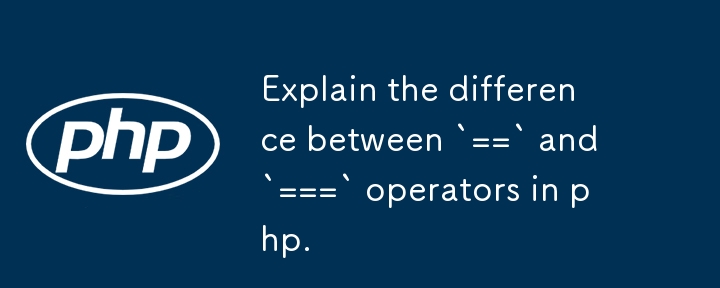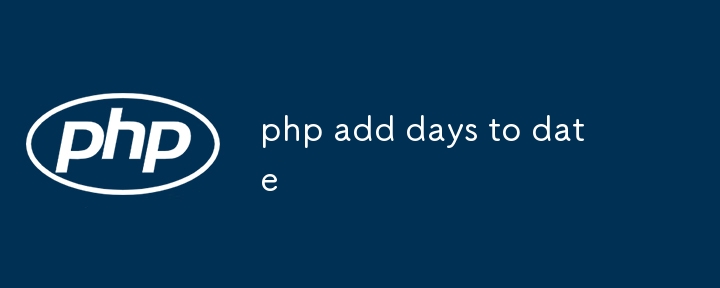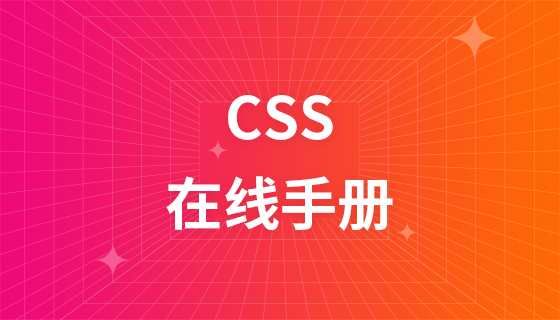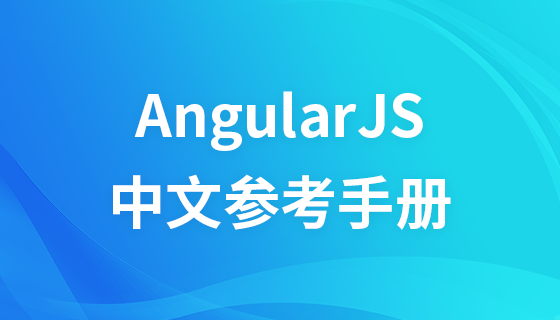
Course Introduction:The difference between == and == in PHP is that: == is a loose comparison, only the values ??are compared and type conversion is performed, for example, 0=="0" is true; while === is a strict comparison, which compares both values ??and types, such as 0==="0" is false. Common type conversion rules include converting a string to a number when compared to a number, converting a Boolean value to 0 or 1, etc. It is recommended to use === first to avoid unexpected errors. For example, when checking the return value of strpos(), you must use === to determine whether it is false.
2025-07-12 comment 0 1023

Course Introduction:It is recommended to use the DateTime class to add a number of days to dates in PHP, with clear code and flexible functions. The DateTime class introduced in PHP5.2 supports object-oriented operations. The example code is: $date=newDateTime('2024-10-01'); $date->modify('5days'); echo$date->format('Y-m-d'); The output result is 2024-10-06; this method is highly readable and supports time zone setting and formatting output. You can also use strtotime() to implement it, but you need to pay attention to the time zone problem. The example is: $newDate=date("
2025-07-05 comment 0 800

Course Introduction:This article will explain in detail how to efficiently determine whether there are multiple different values in PHP arrays. By using the array_count_values() function, we can quickly count the number of occurrences of each value in the array, and then determine whether the original array contains more than one unique value by checking the number of elements in the result array. This approach is especially suitable for scenarios where array elements need to be homogeneous, such as verifying that the seller ID in the order is consistent.
2025-08-05 comment 0 653

Course Introduction:CSS refers to the weighting mechanism used by the browser to determine which style rules are preferred. When multiple rules act on the same element, a high-weight rule takes effect. For example, #mainp is more specific than p, and will cover the color blue. The calculation method is based on the selector type and is divided into four levels: a is the number of inline styles, b is the number of ID selectors, c is the number of classes, attributes, and pseudo-classes, and d is the number of elements and pseudo-elements. Compare bit by bit when comparing, and compare a→b→c→d in sequence like a phone number. Common misunderstandings include abuse!important, over-necking selectors, dependency ID selectors, etc. It is recommended to use clear structure and unified class name naming to reduce conflicts, and you can check the style coverage through the developer tool and adjust the selector rights.
2025-07-24 comment 0 187

Course Introduction:1. Use performance analysis plug-in to quickly locate problems. For example, QueryMonitor can view the number of database queries and PHP errors, BlackboxProfiler generates function execution reports, and NewRelic provides server-level analysis; 2. Analyzing PHP execution performance requires checking time-consuming functions, debugging tools usage and memory allocation, such as Xdebug generates flame graphs to assist in optimization; 3. Monitor database query efficiency can be checked through slow query logs and index checks, QueryMonitor can list all SQL and sort by time; 4. Combining external tools such as GooglePageSpeedInsights, GTmetrix and WebPageTest to evaluate front-end plus
2025-07-07 comment 0 505

Course Elementary 13891
Course Introduction:Scala Tutorial Scala is a multi-paradigm programming language, designed to integrate various features of object-oriented programming and functional programming.

Course Elementary 82444
Course Introduction:"CSS Online Manual" is the official CSS online reference manual. This CSS online development manual contains various CSS properties, definitions, usage methods, example operations, etc. It is an indispensable online query manual for WEB programming learners and developers! CSS: Cascading Style Sheets (English full name: Cascading Style Sheets) is an application used to express HTML (Standard Universal Markup Language).

Course Elementary 13237
Course Introduction:SVG is a markup language for vector graphics in HTML5. It maintains powerful drawing capabilities and at the same time has a very high-end interface to operate graphics by directly operating Dom nodes. This "SVG Tutorial" is intended to allow students to master the SVG language and some of its corresponding APIs, combined with the knowledge of 2D drawing, so that students can render and control complex graphics on the page.

Course Elementary 24695
Course Introduction:In the "AngularJS Chinese Reference Manual", AngularJS extends HTML with new attributes and expressions. AngularJS can build a single page application (SPAs: Single Page Applications). AngularJS is very easy to learn.

Course Elementary 27541
Course Introduction:Go is a new language, a concurrent, garbage-collected, fast-compiled language. It can compile a large Go program in a few seconds on a single computer. Go provides a model for software construction that makes dependency analysis easier and avoids most C-style include files and library headers. Go is a statically typed language, and its type system has no hierarchy. Therefore users do not need to spend time defining relationships between types, which feels more lightweight than typical object-oriented languages. Go is a completely garbage-collected language and provides basic support for concurrent execution and communication. By its design, Go is intended to provide a method for constructing system software on multi-core machines.
JQuery not capturing dropdown value
2023-09-11 14:22:42 0 1 773
Laravel Modal does not return data
2024-03-29 10:31:31 0 1 659
Can I use the automatic generation module of thinkphp5 in Windows 7 system? How to configure and use
2017-10-10 17:04:14 0 2 1448
2017-10-10 19:25:59 0 4 3008
To use mcrypt_get_key_size() in php study, how to enable mcrypt_
2017-10-10 19:47:34 0 1 1230